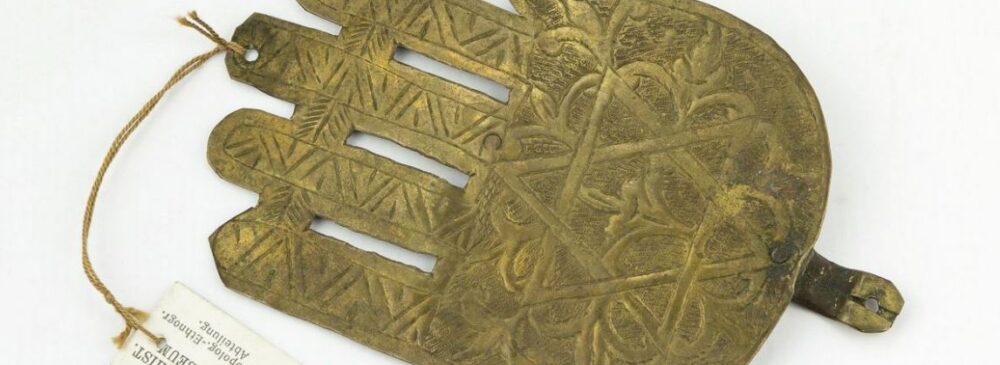When searching for “Glück” (luck)…
Jan 5, 2021 | JMW News

…you will find 78 entries in the inventory of the Jewish Museum Vienna, including the family name Glück, “Glückwünsche” (congratulations) and blessings for the Jewish New Year in autumn, birthday wishes (“Glückwünsche”) and closings at the end of letters. The Hebrew word in the spelling “mazal” appears nine times, including on marriage certificates, wedding rings and Torah wimpels. The term “amulet” yields 64 hits.

Image © JMW
This object is exhibited in the Visible Storage on the third floor of the Jewish Museum Vienna. It is a “chamsa” – from the Hebrew word “chamesh,” meaning “five,” the five fingers of one hand. Visitors who know and use the item as a lucky charm in the form of a wide variety of pendants – chains, bracelets, door key or car key chains – recognize it as the “Hand of Fatima.” Fatima is the youngest daughter of the Prophet Mohammed. Her descendants were the only ones to survive into adulthood and she is considered the forbearer of all of Mohammed’s descendants. In this unobtrusive way, cultures and religions coalesce. Who would not want to protect themselves from all kinds of evil and adversity?

Image © JMW
Directly next to it is an amulet that is worn by infants and children. Quotes from the Qur’an are found in the capsules. Just how this object ended up in the Jewish Museum Vienna collection is not clear. It is not noted down in the inventory book of the old Jewish Museum. The colleagues in the first Jewish Museum, founded in 1895, were very precise, so that the object should actually be able to be found. It is more likely that this amulet was associated with the collection of the first Jewish museum in the 1940s, even though it belonged to the holdings of the Museum of Ethnology at the time. After the closing of Jewish Museum at Malzgasse 16 in May 1938, half of the holdings were inventoried and handed over to other Viennese museums. These items were gathered for the antisemitic exhibition at the Natural History Museum, which ran from 1939 to 1942. In the 1950s, the objects from the first Jewish museum were returned to the Jewish Community of Vienna.

Image © JMW
This “Kindbettzettel” (a tablet or amulet carrying incantations to protect newborns and recent mothers from Lilith) also comes from the collection of the old Jewish Museum and was exhibited in the “Gute Stube” (“Shabbat Room”) designed by Isidor Kaufmann. This very popular “room installation” was intended to provide information about the weekly Shabbat day of rest with furnishings and ritual objects. Newborn babies and women who have recently given birth are at risk of being haunted by Lilith, Adam’s first wife. It is best to put these “Kindbettzettel” on all four walls in the room of the woman who has recently given birth, in order to keep Lilith away. Lilith did not want to kowtow to Adam, left Paradise and did not return. Since then she has been haunting the night, stealing semen from men and killing newborn children. In feminism, Lilith became the counter figure to the biblical Eve.
You can take a closer look at the “Kindbettzettel” here.
At the turn of the Gregorian calendar year, the team at the Jewish Museum Vienna wishes you all the best or, to speak with the famous Aunt Jolesch: “Gott soll einen hüten vor allem, was noch ein Glück ist” (“God shall guard you from everything that is still luck”). The German formulation actually reads “abhüten,” comes from the Yiddish verb “ophiten,” and means “to guard/safeguard.” This is a saying with high practical value, because things can always get worse…
Cover image © JMW
